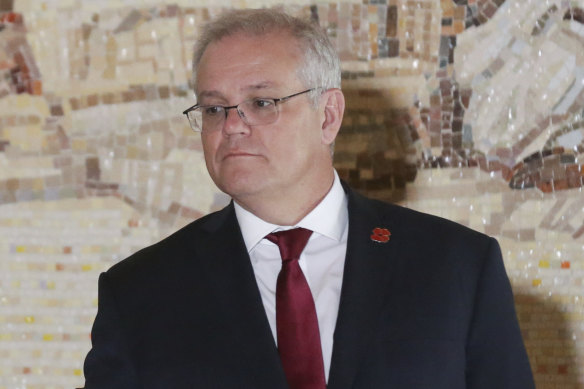This was published 11 months ago
Opinion
Page 97 of the budget kept me awake at night, and is a stain on Morrison’s legacy
Shane Wright
Senior economics correspondentThere are tens of thousands of pages to the federal budget. But a single paragraph on page 97, which could easily have been missed, demands to be read and understood by all Australians.
It shows a decision by the Albanese government to fix a situation left by its predecessors that is beyond comprehension, and a stain on the Morrison government’s legacy.

Throughout his time as prime minister, Scott Morrison said Australia should do more to support veterans. Credit: Alex Ellinghausen
The paragraph reveals an extra $6.5 billion going to defence veterans over the next five years, which the government says is “largely due to more claims being processed because of increased staffing levels”, and which “results in increased payments to veterans”.
I’ve covered every budget since Peter Costello handed down his “back in black” budget of 1998. Normally, I sleep well after them. But that one sentence kept me awake for days, thinking about the veterans left without proper support, about my own relatives and friends who served their country and how we got to a position where a government has to spend so much money to rectify a problem not of its own making.
This $6.5 billion funding allocation is an indictment against the Morrison government, the backstory to it enough to make your blood boil.
In 2018, Scott Morrison said he understood “first-hand the battles so many veterans face when they leave the defence forces”, and argued that as a nation, more could always be done to recognise the men and women who had served in uniform. Unfortunately, that didn’t extend to processing veterans’ entitlement claims.
By April 2023, the average processing time for a veteran’s claim was 435 days, while 36,271 claims – almost half of those lodged – hadn’t even been looked at (known as “unallocated” cases).
This was a known and growing issue for the Coalition. In March 2022, ahead of Josh Frydenberg’s final budget, then veterans’ affairs minister Andrew Gee threatened to resign unless extra money was put aside to clear the backlog, which at the time was about 60,000 unallocated cases.
That was 60,000 veterans, partners or widows of people who had served in the Australian forces waiting for someone to start looking at their claim for financial support.
Within the veterans’ community, the term “delay, deny, die” is used to describe the system. It means if a government delays the start of processing a claim, and then denies the initial claim, the veteran is likely to have died before they are finally paid what they are owed.
It’s hard to know what’s worse – that veterans have coined a term for this situation or that many believe it is a deliberate choice by government.
Gee’s 2022 threat seemingly touched a nerve, and he was promised an additional 90 departmental employees to deal with the backlog. The 90 extra staff barely touched the sides.
The incoming Labor government, including new Veterans’ Affairs Minister Matt Keogh, quickly realised the disaster left by the previous bunch and confidentially talked to veterans’ affairs ministers going all way the way back to the Rudd government to understand what he had been handed.
In the October 2022 budget, handed down just five months after Labor took over from the Coalition, Treasurer Jim Chalmers allocated funding for a further 500 employees, and last week, funding for an extra 141 staff was allocated to make sure claims are processed, and so that our veterans can start getting their entitlements.
This goes to the heart of the problem left by the Morrison government.
To save costs across a number of sectors, including Veterans’ Affairs, it used labour hire companies and short-term employment contracts in favour of permanent employees. But one of the biggest problems with this model is that staff barely stay long enough to remember their logon details before their contract is up.
In Veterans’ Affairs, it takes up to six months to train the specialist staff responsible for overseeing claims. And so, the previous government’s use of labour hire ended up being a disaster for the department and veterans.
Unsurprisingly, the department has become more efficient since switching back to public service employees. The backlog of unallocated cases has reduced to just 2569 and the processing waiting time, while still far too long, has dropped by 62 days.
What’s truly outrageous is not just that these claims took so long to be processed, but that this $6.5 billion would have left the government’s coffers long ago and already be in the pockets of our veterans had the system not been in such a poor condition.
Yet even in light of this, Opposition Leader Peter Dutton complained last week that the number of public servants has swelled under the Albanese government, declaring the Coalition sees defence spending as “much more of a priority than office staff in Canberra”.
What Dutton seemingly failed to appreciate, though, is that hundreds of those staff in Canberra are the ones looking after the veterans who were left unsupported by his former boss.
There are 20,000 veterans out of the wars in Iraq and Afghanistan alone. This isn’t an issue that’s going away, and the claims coming forward show more veterans are now suffering multiple problems, ranging from post-traumatic stress to physical injuries.
Keogh, Chalmers and Finance Minister Katy Gallagher are still a way from fixing all the problems within Veterans’ Affairs. But clearing this backlog is a major step in the right direction. They’ve done it without fanfare. And they’ve made a conscious decision not to overtly politicise a situation which was an absolute mess and ripe for point scoring and public criticism.
Shane Wright is a senior economics correspondent and regular columnist.